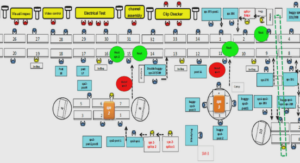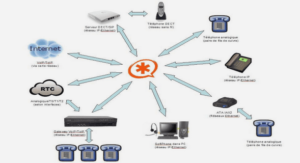The LHC is a very large scientific instrument, which was built with the aim of investigating the fundamental laws of the nature [1]. It is located at the Centre of the European Organization for Nuclear Research (CERN) in Geneva, Swizerland. The LHC is a proton-proton collider, with the capability to collide proton beams up to an energy in the center of mass of 14 TeV. In order to produce beams with such high energy, LHC uses four stages of acceleration chains before reaching the main ring .
At the intersection points of the LHC, there are four main detectors: ATLAS [2], ALICE [3], CMS [4], and LHCb [5]. The two general purpose detectors, ATLAS and CMS, are designed to study the theory of the particle interactions of the Standard Model (SM) and the physics beyond it, ALICE is optimized for the study of heavy ion collisions and LHCb is dedicated to the study of charge-conjugation/parity violation effects and of rare decays of heavy-flavour particles. The work of this thesis is performed in the context of the upgrade of the ATLAS detector.
The ATLAS detector[2, 6, 7] is the largest detector of the LHC. It is 44 m long and has a diameter of about 25 m. One of the most important goals of ATLAS was to search for the missing piece of the Standard Model, the Higgs boson, which was found in 2012[8]. The purpose of the ATLAS detector is now to study in detail this new boson, the Standard Model and to reveal possible new effects beyond it. ATLAS is composed of three high precision sub-detector systems which are concentric around the beam pipe, The innermost part of the detector, the tracking system, imbedded in a solenoidal magnetic field, is used to reconstruct the track of the charged particles and measure their momenta. Outside the tracking system, the electromagnetic and hadronic calorimeters are used to identify and measure the energy of the photons, electrons and hadrons, respectively. The muon detector system, finally, is used to identify and measure the momenta of the muons.
A right-handed coordinate system is defined in ATLAS. The beam interaction point is taken as the origin. The y-axis is defined as pointing from the interaction point to upwards, the x-axis is defined as pointing from the interaction point to the center of the LHC ring, and the z-axis is chosen along the beam direction. The half of the detector at positive z is referred as A-side, the other half is called C-side. Positions in the plane (x-y), transverse to the beam direction are often described in terms of r-ϕ coordinates. The radial coordinate r, measures in the plane (x-y), the distance from the beam line. The azimuthal angle, φ, is the angle around the beam axis, and the polar angle θ is the angle with respect to the beam axis.
The sub-detector system closest to the beam pipe, the Inner Detector(ID), is composed of the Pixel Detector, the Semi Conductor Tracker (SCT) and the Transition Radiation Tracker (TRT) . It has a length of 6.2 m and a diameter of 2.1 m. This part of detector is designed to measure the charge and the momentum of the traversing charged particles by measuring their trajectory. The coverage of the ID is up to |η| < 2.5.
The Pixel Detector is the closest sub-detector to the interaction point, therefore it has to stand high radiation doses. For this reason it is build with hybrid radiation-hard silicon pixel sensors [9]. During Run 1 (2010-2012) of the LHC data taking, the detector was composed of three barrel layers and three end-cap disks. With this configuration, the Pixel detector is able to provide three measurements for each charged particle with a resolution of 10 μm in the (rϕ) plane and 115 μm along the z direction. During the LHC long shut-down, which took place in 2013 and 2014, an additional barrel layer was installed called the Insertable B Layer (IBL).
The Transition Radiation Tracker
At the outermost part of the ID, there is the Transition Radiation Tracker (TRT) composed of drift-tubes [16, 17, 18]. The TRT is 5.3 m long and has a diameter of 2.5 m, thus, its coverage is η <2.0. The gas in which the particles drift is a mixture of 70% Xe, 27% CO2 and 3% O2. With this gas mixture, a hit resolution of 130 μm is achieved.
The Calorimeters
The ATLAS Calorimeters are located outside the ID system, and include the Electromagnetic calorimeters[19] delicated to the measurement of the electron and photon energy, and the Hadronic calorimeters focusing on the measurement of hadronically interacting particles [20]. By absorbing the energy, most of the particles will be stopped by the Calorimeter system, except the muons and the neutrinos.
The Muon Spectrometer
The Muon Spectrometer(MS) [21, 22] is used to identify the muons and measure their momentum. It is located outside the Calorimeter system. The main components of the MS are the toroid magnet system, the monitored drift tubes, the cathode strip chamber, and the resistive-plate chambers.
1 The LHC and the ATLAS Experiment |





